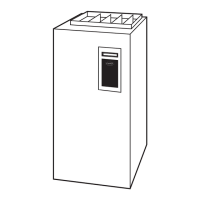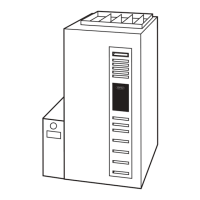humidifier terminal HUM. The inducer motor IDM will
remain energized for a 15-second post-purge period. The
blower motor BLWM and air cleaner terminal EAC-1 will
remain energized at low-heat airflow or transition to low-heat
airflow for 90, 120, 150, or 180 seconds (depending on
selection at blower-OFF delay switches). The furnace control
CPU is factory-set for a 120-second blower-OFF delay.
TWO-STAGE THERMOSTAT AND TWO-STAGE HEATING
See Fig. 60 for thermostat connections
NOTE: In this mode, the low-heat only switch SW1-2 must be
ON to select the low-heat only operation mode in response to
closing the thermostat R-to-W1 circuit. Closing the thermostat
R-to-W1-and-W2 circuits always causes high-heat operation, re-
gardless of the setting of the low-heat-only switch.
The wall thermostat ″calls for heat″, closing the R to W1 circuit for
low-heat or closing the R to W1-and-W2 circuits for high-heat.
The furnace control performs a self-check and verifies the low-
heat and high-heat pressure switch contacts LPS and HPS are
open.
The start-up and shutdown functions and delays described in item
1. above apply to 2-stage heating mode as well, except for
switching from low- to high-heat and vice versa.
1. Switching From Low- To High- Heat-If the thermostat R to
W1 circuit is closed and the R to W2 circuit closes, the furnace
control CPU will de-energize the high-heat pressure switch
relay HPSR to close the NC contact and slowly increase the
inducer motor speed until the high-heat pressure switch HPS
closes. When the high-heat pressure switch closes, the high-
heat gas valve solenoid GV-HI is energized and the inducer
motor RPM is noted by the furnace control CPU. The RPM is
used to evaluate vent system resistance. This evaluation is
then used to determine the required RPM necessary to operate
the inducer motor in high-heat mode. The blower motor
BLWM will transition to high-heat airflow five seconds after
the R to W2 circuit closes.
2. Switching From High- To Low- Heat- If the thermostat R to
W2 circuit opens, and the R to W1 circuit remains closed, the
furnace control CPU will energize the high-heat pressure
switch relay HPSR to open the NC contact and slowly
decrease the inducer motor speed to the required low-heat
RPM. When the high-heat pressure switch HPS opens, the
high-heat gas valve solenoid GV-HI is de-energized. When
the inducer motor IDM reduces pressure sufficiently, the
high-heat pressure switch HPS will open. The gas valve
solenoid GV-M will remain energized as long as the low-heat
pressure switch LPS remains closed. The blower motor
BLWM will transition to low-heat airflow five seconds after
the R to W2 circuit opens.
COOLING MODE
The thermostat “calls for cooling”
1. Single-Speed Cooling
(See Fig. 28 for thermostat connections.)
The thermostat closes R-to-G-and-Y circuits. The R-to-Y
circuit starts the outdoor unit, and R-to-G-and-Y/Y2 circuits
start the furnace blower motor BLWM on cooling airflow.
Cooling airflow is based on the A/C selection shown in Fig.
50.
The electronic air cleaner terminal EAC-1 is energized with
115-v when blower motor BLWM is operating.
When the thermostat is satisfied, the R-to-G-and-Y circuits are
opened. The outdoor unit will stop, and furnace blower motor
BLWM will continue operating at cooling airflow for an
additional 90 sec. Jumper Y/Y2 to DHUM to reduce the
cooling off-delay to 5 seconds. (See Fig. 32.)
2. Single-Stage Thermostat and Two-Speed Cooling (Adap-
tive Mode)
(See Fig. 61 for thermostat connections.)
This furnace can operate a two-speed cooling unit with a
single-stage thermostat because the furnace control CPU
includes a programmed adaptive sequence of controlled op-
eration, which selects low-cooling or high-cooling operation.
This selection is based upon the stored history of the length of
previous cooling period of the single-stage thermostat.
NOTE: The air conditioning relay disable jumper ACRDJ must
be connected to enable the adaptive cooling mode in response to a
call for cooling. (See Fig. 32.) When in place the furnace control
CPU can turn on the air conditioning relay ACR to energize the
Y/Y2 terminal and switch the outdoor unit to high-cooling.
The furnace control CPU can start up the cooling unit in either
low- or high-cooling. If starting up in low-cooling, the furnace
control CPU determines the low-cooling on-time (from 0 to 20
minutes) which is permitted before switching to high-cooling.
If the power is interrupted, the stored history is erased and the
furnace control CPU will select low-cooling for up to 20
minutes and then energize the air conditioning relay ACR to
energize the Y/Y2 terminal and switch the outdoor unit to
high-cooling, as long as the thermostat continues to call for
cooling. Subsequent selection is based on stored history of the
thermostat cycle times.
The wall thermostat ″calls for cooling″, closing the R to
G-and-Y circuits. The R to Y1 circuit starts the outdoor unit
on low-cooling speed, and the R to G-and-Y1 circuits starts
the furnace blower motor BLWM at low-cooling airflow
which is the true on-board CF selection as shown in Fig. 50.
If the furnace control CPU switches from low-cooling to
high-cooling, the furnace control CPU will energize the air
conditioning relay ACR. When the air conditioning relay ACR
is energized the R to Y1-and-Y2 circuits switch the outdoor
unit to high-cooling speed, and the R to G-and-Y1-and-Y/Y2
circuits transition the furnace blower motor BLWM to high-
cooling airflow. High-cooling airflow is based on the A/C
selection shown in Fig. 50.
NOTE: When transitioning from low-cooling to high-cooling the
outdoor unit compressor will shut down for 1 minute while the
furnace blower motor BLWM transitions to run at high-cooling
airflow.
The electronic air cleaner terminal EAC-1 is energized with
115 vac whenever the blower motor BLWM is operating.
When the thermostat is satisfied, the R to G-and-Y circuit are
opened. The outdoor unit stops, and the furnace blower
BLWM and electronic air cleaner terminal EAC-1 will remain
energized for an additional 90 seconds. Jumper Y1 to DHUM
to reduce the cooling off-delay to 5 seconds. (See Fig. 32.)
3. Two-Stage Thermostat and Two-Speed Cooling
(See Fig. 60 for thermostat connections)
NOTE: The air conditioning relay disable jumper ACRDJ must
be disconnected to allow thermostat control of the outdoor unit
staging. (See Fig. 32.)
The thermostat closes the R to G and-Y1 circuits for low-
cooling or closes the R to G and-Y1-and-Y2 circuits for
high-cooling. The R to Y1 circuit starts the outdoor unit on
low-cooling speed, and the R to G-and-Y1 circuit starts the
furnace blower motor BLWM on low-cooling airflow which is
the true on-board CF selection as shown in Fig. 50. The R to
Y1-and-Y2 circuits start the outdoor unit on high-cooling
39

